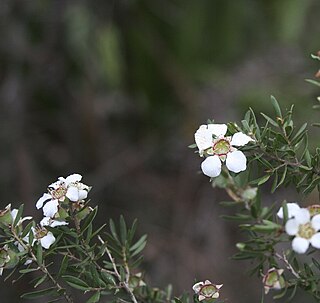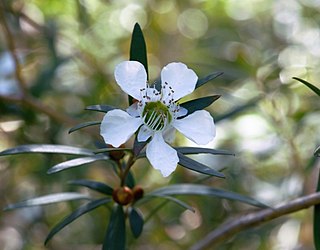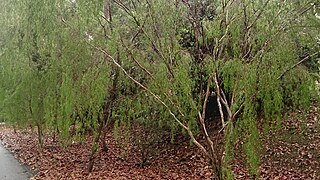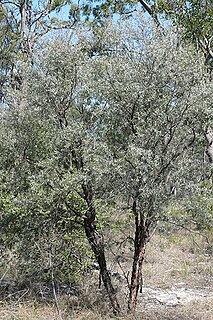
Leptospermum laevigatum, commonly known as the coast tea tree, is a species of shrub or small tree that is endemic to south-eastern Australia, but has been widely introduced in other places where it is often considered to be a weed. It has thin, rough bark on the older stems, narrow egg-shaped leaves, relatively large white flowers and flat topped fruit that is shed shortly after reaching maturity.

Leptospermum petersonii, commonly known as lemon-scented teatree, is a species of shrub or small tree that is endemic to eastern Australia. It has thin, fibrous or flaky bark, often strongly-scented elliptic to lance-shaped leaves, white flowers and fruit that are retained for several years. It is commonly grown as an ornamental and is regarded as a minor environmental weed in some areas.

Leptospermum juniperinum, commonly known as the prickly tea tree, is a species of broom-like shrub that is endemic to eastern Australia. It has narrow, sharply pointed leaves, white flowers usually arranged singly on short side shoots and small fruit that remain on the plant when mature.

Leptospermum morrisonii is a shrub or small tree that is endemic to New South Wales. It has strongly aromatic, elliptical to lance-shaped or curved leaves, white or greenish white flowers and fruit that remain on the plant. It occurs in the south-east of the state.

Leptospermum obovatum, commonly known as river teatree, is a species of shrub that is endemic to south-eastern continental Australia. It has egg-shaped or lance-shaped leaves that are narrower at the base, white flowers usually arranged singly on short side shoots and fruit that remains on the plant until it dies.

Leptospermum madidum is a species of shrub or small tree that is endemic to north-western Australia. It has weeping branches, smooth bark, pale green linear leaves, small white flowers and thin-walled fruit.
Leptospermum amboinense is a species of tree that is native to Malesia and North Queensland. It has rough bark, sessile, narrow elliptical leaves, white flowers and sessile, conical to hemispherical fruit.
Leptospermum anfractum is a species of spreading shrub that is endemic to Queensland. It has a smooth, twisted trunk, linear leaves, white flowers borne in leaf axils and bell-shaped to hemispherical fruit. It grows on rocky ridges and cliff edges.
Leptospermum barneyense is a species of shrub that is endemic to the Mount Barney National Park in Queensland. It has rough, fibrous bark, young branches with conspicuous flanges, lance-shaped leaves, white or pink flowers and hemispherical fruit.
Leptospermum benwellii is a species of shrub that is endemic to the Nymboida National Park in New South Wales. It has smooth bark, young branches with conspicuous flanges, narrow elliptical leaves, white flowers and thin-walled, bell-shaped to hemispherical fruit.

Leptospermum brachyandrum is a species of shrub or small tree that is endemic to eastern Australia. It has smooth bark, linear to lance-shaped leaves and white flowers and usually grows along creeks, often in water.

Leptospermum brevipes, commonly known as the slender tea-tree, is a species of shrub or small tree that is endemic to eastern Australia. It has fibrous bark on the main stems, smooth bark on young stems, narrow elliptical to narrow egg-shaped leaves, white flowers and hemispherical fruit that is shed when mature.

Leptospermum emarginatum, commonly known as the twin-flower tea-tree or twin flower teatree, is a species of shrub that is endemic to south-eastern Australia. It has rough bark on the older stems, lance-shaped leaves with the narrower end towards the base and a small notch at the tip, white flowers in groups of up to five and hemispherical fruit that falls off when mature.

Leptospermum lamellatum is a species of shrub or small tree that is endemic to inland Queensland and has distinctive reddish, layered bark. It has narrow elliptical leaves, white flowers and small fruit that fall from the plant when mature.
Leptospermum luehmannii is a species of shrub or small tree that is endemic to Queensland. It has glossy green elliptic leaves, white flowers and fruit that falls from the plant shortly after the seeds are released.
Leptospermum minutifolium, commonly known as the small-leaved tea-tree, is a species of shrub that is endemic to eastern Australia. It has relatively small egg-shaped leaves, white flowers borne singly on the ends of branches and fruit that remains on the plant.

Leptospermum myrtifolium, commonly known as the myrtle tea-tree or grey tea-tree, is a species of shrub that is endemic to south eastern Australia. It has broad egg-shaped to elliptical leaves, white flowers usually borne singly on short side shoots, and fruit that remains on the plant until it dies.
Leptospermum oreophilum, commonly known as the rock tea tree, is a shrub that is endemic to the Glass House Mountains in southern Queensland. It has firm, rough bark on the older stems, elliptical leaves with a short, blunt point on the tip, relatively large white flowers arranged singly on side shoots and fruit that remains on the plant until it dies.
Leptospermum polyanthum is a rigid, spreading shrub or small tree that is endemic to New South Wales. It has thin, rough bark, young stems that are hairy at first, elliptical leaves, relatively small white flowers and fruit are shed when the seeds are mature.

Leptospermum purpurascens, commonly known as the purple-stemmed turkey bush, is a shrub or small tree that is endemic to far north Queensland. It has bark that is purple when new, elliptical to broadly lance-shaped leaves, relatively small white flowers arranged in pairs and small fruit that falls from the plants when the seeds are released.











